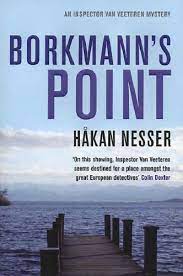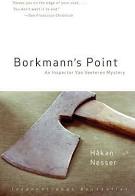Borkmann’s Point (2007) by Håkan Nesser.
GoodReads metadata is 336 pages rated 3.73 by 8,320 litizens.
Genre: Police procedural.
Verdict: Measured.

Chief Inspector van Veeteren is dispatched to sleepy Kaalbringen (Pop. 45,000) to advise the local plod on the investigation of a gruesome murder. Most covers of this tome show a butcher’s ax. VV is reluctant to go but needs must, while the local plod, only too glad to have someone with whom to share the blame, welcomes him. Had he looked for Kaalbringen on a map, he would have failed to locate it as it is fictional. While the author is Swedish the names of characters are a mix of Flemish, French, English, Polish, and Swedish – very Euro. Having said that, it is also true there are no Asians or dark skins around. So it is only Euro. (Though by the way the currency is not the Euro but the guilder.)
The individual characters are well delineated from the ambitious female constable to her bumbling male partner, to the soon to retire local chief of police with whom VV plays chess (which is a metaphor for the plot but also a part of it), to the chief’s heir apparent who tensely strives not to put a foot wrong in front of VV and as a result barely moves.

Even as VV arrives another axed corpse is found and then a week later another, three in all: Chop, chop, and chop. The victims seem to have had nothing in common, and there are slight variations in the modus operandi, apart from the ax. The aresponsible media whips up public hysteria which drains police time and budget. It seemed pretty obvious soon enough who the culprit was….but it was a nice trip. Likewise, how could so many people have read the Melnike Report and not notice the missing page with and without page numbers?
The titular Borkmann was VV’s mentor long ago, and his point was that in an investigation there may come a time when gathering yet more information will cloud rather than clarify reality. At the eponymous point there is enough information, enough pieces of the puzzle are there and it is time to put them together. All pieces are not necessary to get the outline. A skilled investigator learns to recognise that point and then see the whole picture.
As in krimis, so it is in social science, far more information (data) is collected than is ever analysed. It is a design-fault in the way we do social science because the career incentives lie in doing something new, not in raking over old ground for meaning. In most studies the data, whatever form it takes, is examined once for immediate purposes of a publication, and then shelved. Truth to be told, despite two generations of emphasis on methodology most studies are so idiosyncratic in conception that raking them again by another researcher is not possible. I’ll cite PhD completions where the uniqueness of the work is always the money shot. Ergo Borkman’s Point rang a bell for this reader.

This is the second in a long-running series. I read it years ago but retained nothing from it except that I liked it, so when I came across it recently I re-read it. I expect to meet VV again in another book.

